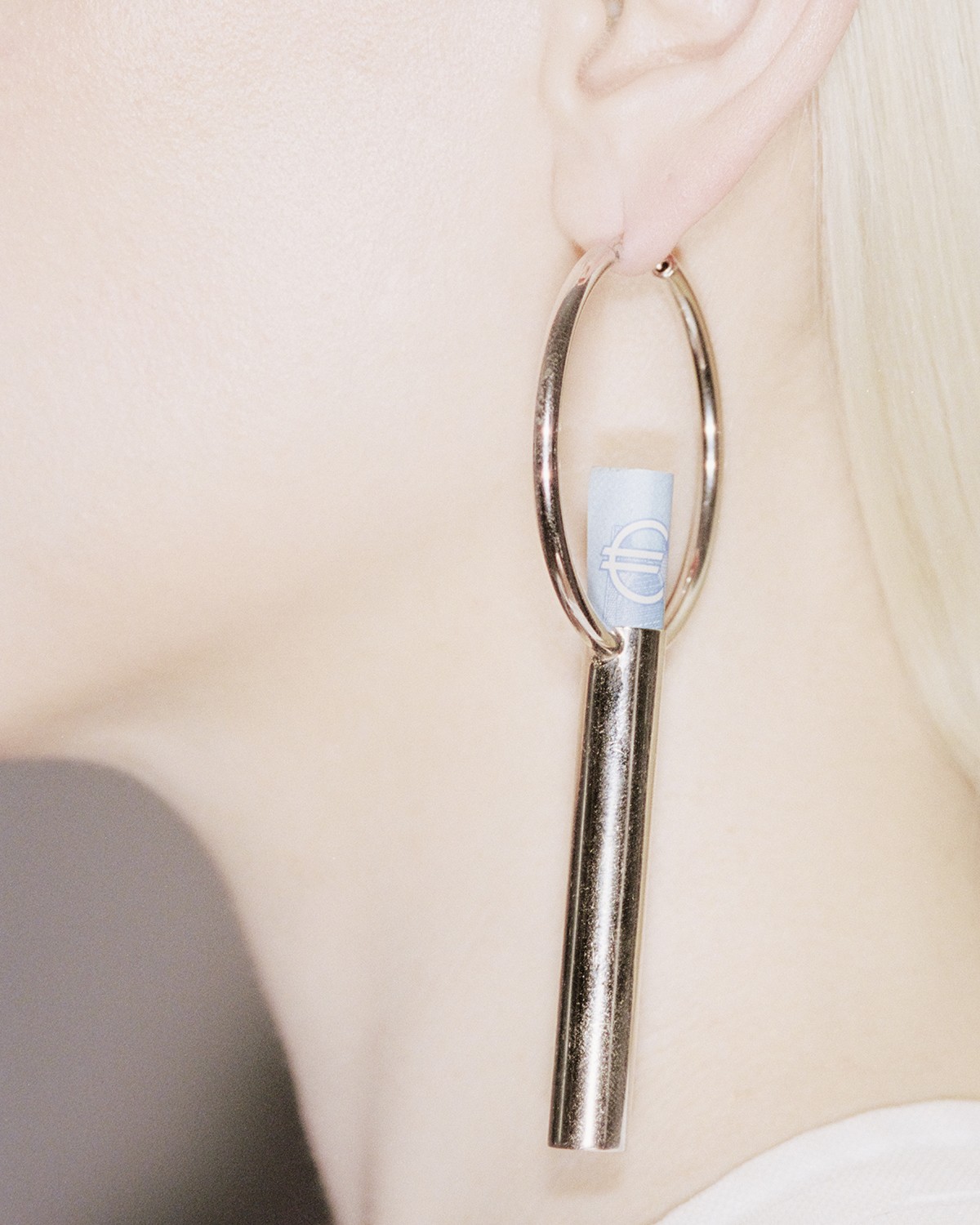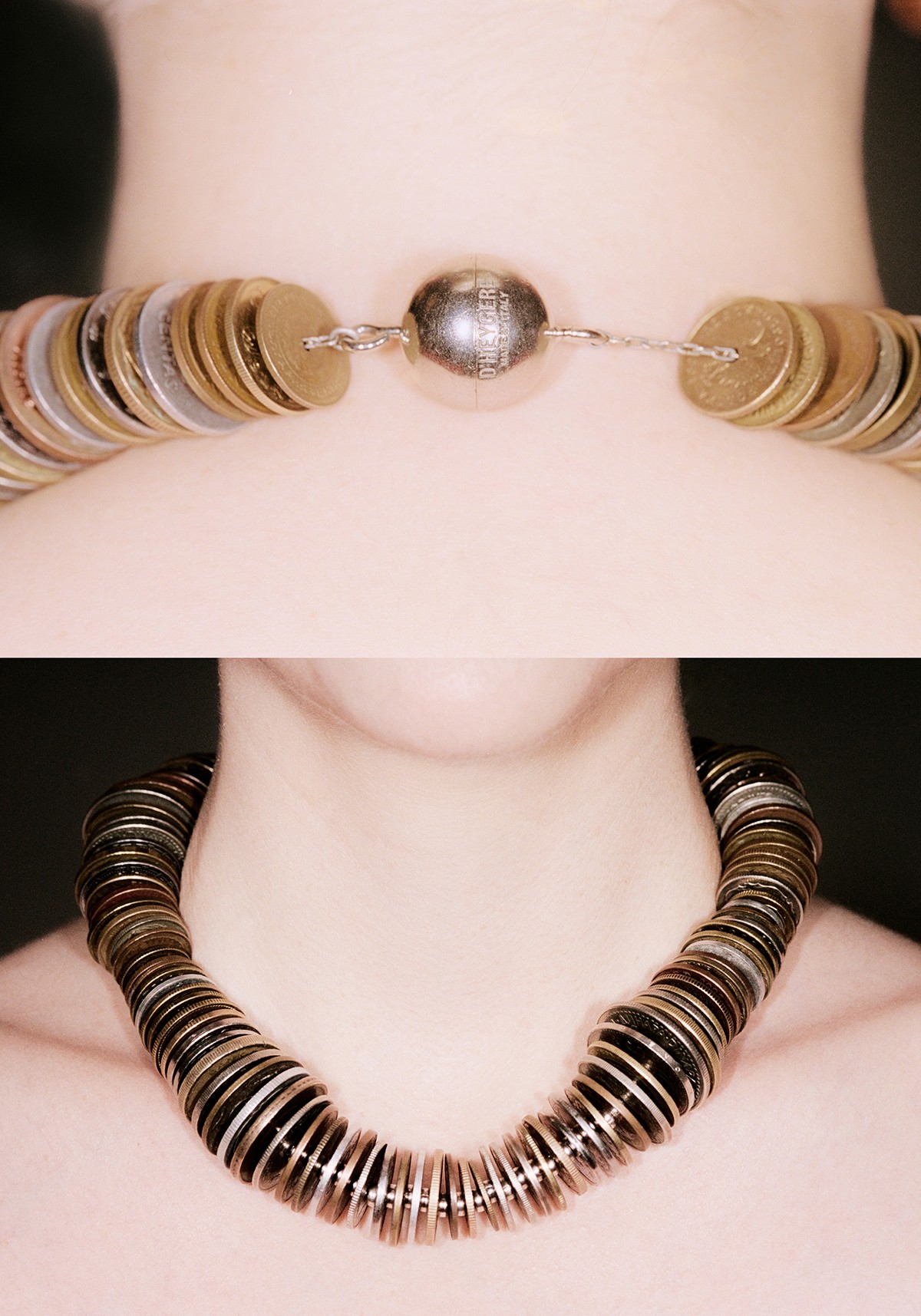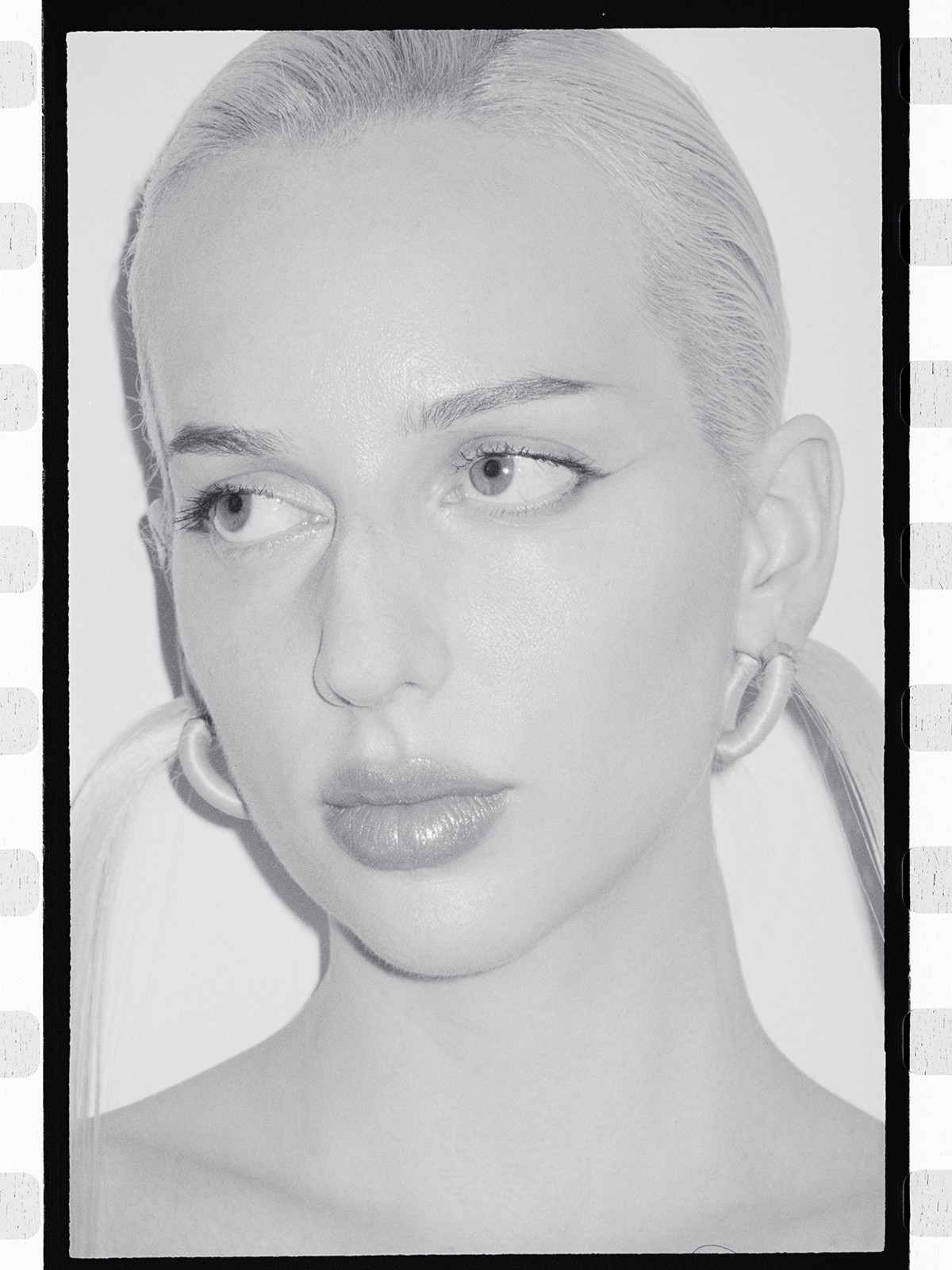Matters of the Heart with Stephanie D’heygere
Culture — 17.11.25
The genius of Stephanie D’heygere is synonymous with invention in the jewelry world. Since launching her eponymous label in 2018, she has decontextualized luxury jewelry into a form of play with her hallmark design philosophy—anything can be an accessory. The manifesto behind the brand is a clever reminder that our objects do not exist within a vacuum, but are anything that the imagination can harness.

Extending her vocabulary into furniture and interiors, D’heygere was invited to oversee Silversquare’s Antwerp space “Officeland” carte blanche last year—a dreamlike affair sprawling over three floors of constructed fantasy, where pop architecture meets a surreal, distinctly D’heygere logic.
The name D’heygere is actually pronounced day-ehrr with a roll in the “r” in her native Belgian French accent. However, in her years of doing business in Paris, the label’s name has become interchangeably transposed into a phonetic French pronunciation, d’hey-jere.
As a jewelry designer, her oeuvre traces back to formative tenures at Maison Margiela, Dior, and various collaborations as a close collaborator of Glenn Martens. She brings her creative force to her own brand, seen in signature collaborations with Gentle Monster, Medea, and I’m Sorry by Petra Collins. In the company of Parisian excellence, she continues to lend her eye to a defining generation of designers from Jacquemus to Coperni.

Last June, TEETH visited Stephanie D’heygere at her Paris studio for an intimate rendezvous.
It’s a blistering 34 Cº afternoon in Le Marais. I see Stephanie as she turns the corner with her boyfriend, Mathieu, a chef in the city. On her shoulder is a huge black foldable garment bag packed full to the brim, which she tells me are her new spoils from the Balenciaga sample sale.
Stephanie leads me across a courtyard grounded at the center by a statuesque tree, providing an umbrella of shade in its foliage. At the ground level of a handsome Haussmann building, a greeting area includes tall stacks of magazines, books, and printed reference materials. Upstairs, her bustling atelier is charged with the rhythm of her work across everything she touches, from stacks of vintage references to D’heygere archives from previous seasons. Images of her current works in progress are pinned to the wall, including Spring/Summer 2026 prototypes for Jacquemus and the Maison Margiela artisanal collection under the helm of Glenn Martens.

What was it like growing up in Belgium?
I come from a small town. It wasn’t anywhere special, but it was safe, with very healthy surroundings, I would say. But I kind of knew, even as a teenager, that I was going to leave this town for sure, but also Belgium. I was always dreaming of going far away. I think that was even before knowing that I wanted to work in fashion.
I truly didn’t think that I would end up in Paris because I didn’t think it was exotic enough, because it’s super close. It’s right next to Belgium and it’s a language that I already could speak. So [at the time] I wasn’t excited enough.
You’re so lucky, that’s a real privilege. Can you tell me about how you found yourself in Paris with your namesake brand?
Before launching the brand, I was working as an accessories designer, mostly jewelry, for other brands. I started at Margiela, and I worked there for almost five years before going freelance. And two years later, I was at Dior. I then picked up my same freelance clients that I had before. From there, I don’t know, all of a sudden, I was like, Okay, now I’m just going to do the same thing that I did before. Maybe I want to add a new challenge to my professional life.
While freelancing, I started having some ideas that I wasn’t sure if I wanted to give to any client, because I felt like there was something more there. And that’s how I started thinking about how I can create something new. Because I think that’s the idea when you launch your brand. You try to do something new, not something that already exists.
How has running a brand of your own compared to your experience freelancing with your clients?
With the brand, I’m the creative director, so there’s no one on top of me. I’m a bit alone, but I love that I can just do whatever I want. Nobody will tell me, “This isn’t crazy enough,” or “That’s too crazy,” or “This is not going to sell.” It’s a huge freedom. But why I also love to freelance is to have this exchange with a team or a creative director. I love to see how the jewelry will go together with the garments when there’s a fashion show at the end. That’s something I don’t have with the brand. Although we do photoshoots and presentations in the showroom, it’s only accessories.
At this time, I’m not even thinking of just doing the brand. I also don’t think it needs 100% of my time, because it’s a small brand, and it’s accessories. I love going to see my clients, having appointments, and being backstage at the shows. It’s a nice balance and feeds this nice circle. Sometimes, I’ll give what I’m doing for my brand to another client. And when I’m working for clients, maybe I’ll be inspired, but not copying of course. It feels connected. I really love doing both.

Where do you keep track of these most precious ideas?
I have lots of notebooks. I always have a pen and a notebook in my bag, because I never know what I’ll see walking through the streets. Maybe I’ll see something, or a person that is doing some kind of gesture, and I need to write it down—I’m always ready to catch a new idea. I don’t like to write things down on my phone because sometimes it comes with a little sketch.
What was the ground zero idea that brought D’Heygere into the world?
I had this idea of the canister hoops. It was actually the first design that I had in mind for the brand—the hoop earrings with the tube, in which you can insert the flower or a cigarette, or bank notes.
Then, from this, I was like, Accessorize your accessory. I thought that was a concept that was never really seen before. Normally, when you see a piece of jewelry, it is what it is, and then you buy it, you wear it. When you get dressed, it’s the last thing you’re going to add to your outfit. So I thought with the idea of the canister hoops, I can push the boundaries of what accessories are.
Some of the things you create feel like ready-mades in the sense of transforming everyday objects, or the ideas thereof, into wearable jewelry. Is there an extent that you feel like you need to manipulate the object to put your signature on it?
People see us transforming daily objects into jewelry. In the beginning of the brand, that was not so much the case. I don’t really know how it works; it’s just kind of random. I see something, and I’m like, This could be a nice accessory.
And then there are the ready-mades. It can be super, super fast, like last season, where I made these hair clip earrings. And it’s really a hair clip with an added pin, and then it becomes an earring. But sometimes, we go a little bit further. The next collection is going to be even more object-based.
Well, I can’t wait to see.
On our Instagram, we have the mantra “everything can become an accessory.” We invite people to take an object very spontaneously that surrounds them, put them in a certain way on your body, and then it becomes an accessory.
She demonstrates an example, balancing her lighter on her fingers, and I see a glimpse of what it could look like fashioned as a D’heygere multi-finger ring.
We’re getting a lot of images from people, and now we’re working on a book to put all these images together, and I have to say, it’s also becoming an inspiration for future pieces.
I love the idea of that. It really feels like your world is being built in collaboration with the customer.
Yes, we also have a lot of accessories in which you would add objects, like the canister hoops and on the Vaquera necklace, that can be inserted on all different things to make it your own. Quite like that, the customer can really be a part of it.
It’s really quite special. I also remember seeing the work you did at the Vaquera show last year. That was a fun collaboration.
We did two collabs for the last two shows. We did the jewelry. I love their garments. I was a really big fan and already a customer. I wrote them a message, thinking maybe they’ll be interested. Now they’re moving to Paris. I don’t know if we’ll continue, but I think we have similar visions.

Is there anything you do outside of fashion and jewelry that you’re invested in?
I mean, it depends. I took ceramics classes for a year, but then I realized I made too many ceramics and I didn’t know where to put them anymore. I’m interested in a lot of things, but my real passion is my work and everything that is connected to it.
I love going to exhibitions. I love to feed myself with a lot of information. I sometimes organize with the team to do little excursions, because I think it’s important to teach them, and also to get out of the office, because sometimes it’s just computer, computer, computer.
What’s the last exhibition you visited with the team?
I took the girls to a museum in Paris that I’ve never been to before, called Carnavalet. It’s about the history of Paris. I realized it’s an old jewelry store in Arnouveau style, that was given to the museum, so the whole store is inside of it. It’s amazing—and it’s for free.
I’ve been living here for like, what, 14 years, and I’ve never heard about this [museum]. Even after all these years, there’s still so many things to discover. I think that’s what I really love about Paris.
I love how a city can keep surprising you even after so long. Do you have a favorite object, or a piece of design history, outside of jewelry?
I have a bit of a nice collection of weird lamps. There’s one that’s made out of paper, which is super fragile. I also have a lamp that is made out of Murano glass that’s like a mix between an apple and a strawberry.
I also love Gaetano Pesce. I’ve got some vases from him and also a lamp. It’s crazy because the vase looks like it’s made out of glass, but it’s actually silicone, and it’s super soft. So many people come to my place, and when they touch it, they’re like, “What the fuck? Why is it squishy?” It’s so great, I love his work.
I think that there’s a lot that you can tell about a person by looking at their collecting habits.
Yeah, my style is very eclectic. I see something, and if I really like it, côté coeur, they would say in French.
Right, matters of the heart.
Yes, I see it and immediately fall in love with it, and then I want it. But it’s rare, and it can be anything—maybe a famous design object, but it can be something from the flea markets.

Do you see the brand’s Instagram also functioning as a time machine through your archives?
I realize Instagram is the only tool we communicate on right now. We have a website, although that will be changing soon. But most of the information you can find only on our Instagram for now. So of course, it’s an archive. That’s also why I’m so excited about this book, with all the Manifesto pictures.
Where in the process are you with the Manifesto right now?
It’s been five years since we launched the Manifesto, so it would be nice to celebrate the fifth anniversary. Also, because these are pictures that people take quickly with their iPhones, I feel that these images are going to really mark a period. So publishing it feels very important to me. And maybe, of course, there could be a second edition five years later.
You also see it with Instagram—like, ten years ago, we were putting filters on our pictures. When I look back at my old photos, I think, Oh, because it was what was fashionable then. So now, I think we need to close that moment and see how it’s going to evolve in the future. It’s also a bit of a social book that marks a period of our lives.
Working backwards, you’ve had such an incredible journey from your time studying fashion design in Antwerp, and this formidable archive of work. Is this how you imagined your future then?
At school, you’re learning about your taste and trying to create your own signature. But when I was in school, I have to say, I was very naive. I’m grateful that I went, but when I compare myself to other students, maybe they were a bit more mature and already knew where they were going. It took me a long time to understand how to design. Only in my last year, in my final collection, was there something to say. When I look back on it now, I don’t think it was great, but I could see some things that I’m doing now, with a bit of humorous trompe l’oeil elements.
I remember at school, everybody was obsessed with Margiela. But I was thinking more like, you know, Prada, Chanel, the big classic womenswear brands, and I thought Margiela was something very weird and dark.

And you ended up working for them?
Yes. My friend who was at Margiela doing an internship at the time said to me, “Steph, they’re looking for an intern in the accessories department.” I’m like, Well, okay, and I go for the interview. I met my future boss, and immediately there was this amazing connection. So I thought, more than for the brand, I’m going to go for her, because I feel I can learn a lot from her. Then, I learned about the archive of Margiela. I was like, Okay, what the fuck, this is amazing. Going into the archives opened a whole new world.
You can also see it, of course, in my brand—how it’s marked me in my time there. It’s also where I learned everything. Margiela was perfect for me. Everything happens for a reason.
I’m a big believer of that.
It’s just with me, I feel everything in my life came super late. Like finding a job. At my first job, I was 28. Finding the love of my life, I was also quite old, let’s say. Now we’re thinking about a baby, but it’s fine.
Everyone’s clocks tick at different speeds. When you know, you know.
Absolutely. This is something I learned with time. Before, I wanted everything to come fast, when and where I wanted. But now, I’m just going to trust the universe. That doesn’t mean you have to get lazy for things to come like this. I think there’s a plan for each of us.

Follow Stephanie’s Instagram to stay up-to-date with her latest collections, available on her website.